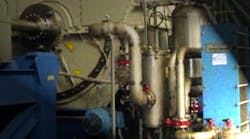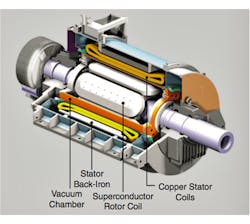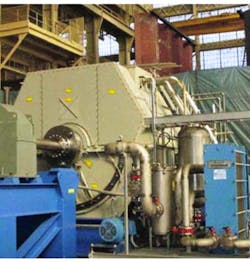Achieving high power density, higher efficiency and superior performance for next-generation transportation systems means reducing the volume and weight of power conversion systems. To that end, cryogenic power devices have demonstrated a number of benefits when compared to their room temperature counterparts.
Related Articles
- Improving Ultra-Low Cryogenic Temperature Control
- Cables Provide Cold Temperature Flexibility in Cryogenic Environments
Power electronics is a critical technology for enabling electromechanical drives, transportation, renewable energy systems and power grids. For the electric vehicles, cryogenic power electronics will not fly, but there are applications for large vehicles such as airplanes, ships, and aircraft carriers. The use of superconducting generator with cryogenic power converter for large wind turbine systems could be of significant improvement in improving the power density and efficiency. In addition to efficiency, weight, and size reductions, cryogenic power converters offer other benefits, including improved switching speed and reliability. All of these characteristics make cryogenic power electronics combined with superconducting motors a viable technology for next generation mass power transportation systems, as well as future aircrafts, ships, and for wind energy systems.
A great deal of research has been done to understand how the various components of power electronic systems function at low temperatures and how these components can be combined to attain higher power density, efficiency and performance.
Superior Performance At Low Temperatures
Cryogenic power electronic systems contain a number of components, all of which have been demonstrated to function well at low temperatures, and in some cases better than their room temperature counterparts. For example, operating power semiconductor devices at cryogenic temperatures have shown to improve switching speed and on-state voltage in comparison to room temperature operation because semiconductor materials seem to have demonstrated better electrical and thermal properties at lower temperatures up to about 50 °K. They also have higher carrier mobility and saturation velocity at low temperatures, which results in high-speed operation capability.
Lower temperatures also significantly improve the thermal conductivities of device and substrate materials. This in turns leads to simpler thermal management, lower on-state power loss and higher reliability, while the switching losses of power devices decrease at cryogenic temperatures, leading to increased overall power conversion efficiency. Significant performance improvements have been reported for many power devices when operated at cryogenic temperatures: for a power metal-oxide-semiconductor field-effect transistor (MOSFET), the on-state resistance falls by as much as five times.
Commercially available MOSFETs in plastic or metal packages also have been found to work well if immersed in a bath of liquid nitrogen, even though these devices have not been designed for cryogenic applications. They can be operated at much higher current levels with lower conduction losses; hence high efficiency power converters could be designed. The characteristics of various power devices at low temperatures down to 20 °K have been investigated, and it appears that among the commercially available power devices, silicon n-channel power MOSFETs are the most optimized for cryogenic applications since they can achieve extremely low on-state resistance and reasonable breakdown voltages.
Insulated-gate bipolar transistors (IGBTs) have been found to work more efficiently at low temperatures with the decrease of on-state voltage and turn-off time, despite the decrease of breakdown levels. The reductions in on-state voltage drop were found to be between 20 and 30 percent, and the turn-off time reduction was by a factor of approximately two to three over the temperature range from room temperature down to 50 °K. Most IGBTs exhibited low forward voltage drop at lower temperatures until 100 °K and a slight increase above this temperature due to carrier freeze out. The switching performance of IGBTs is also shown to improve at low temperatures.
Many passive components and off-the shelf integrated circuits have been proven to operate satisfactorily at temperatures down to 50 °K. Low temperature operation of the capacitors depends on the dielectric medium such as polypropylene, polycarbonate, mica, film, and ceramic; they seem to function properly with decreasing leakage current and dissipation factor at cryogenic temperatures. For magnetic components, magnetic losses generally increase with cooling, and the power dissipation is not too much different than at the room temperature. If superconducting windings are substituted with the copper windings, then the loss comparison between core and windings becomes more promising. A coreless design is even better for inductors at cryogenic environment to get maximum efficiency.
More research needs to be done to better understand the longer-term effects and the repeated cyclic operation of passive components at low temperatures.
Converters Can Go Colder
Research conducted by several universities in partnership with Rolls-Royce to test a DC-DC converter consisting of a number of parallel-connected power MOSFETs at cryogenic temperatures found improved performance in terms of reliability and efficiency.
An advanced radiation-hardened DC-DC converter was found to show good performance in regulation, efficiency, and dynamic characteristics at temperatures down to 73°K, although some instability was observed as the temperature was decreased further. More testing under long-term thermal exposure is needed to fully understand the performance of these converters for potential application in low temperature environments.
The commercial-off-the-shelf integrated circuits such as digital-to-analog and analog-to-digital converters, DC-DC converters, operational amplifiers and oscillators have been investigated for potential use at low temperatures. These components operate well and also maintain stability down to 80 °K.
Superconducting Motors Could Save Money
The advent of high temperature superconductors has created an important opportunity for commercialization of large electric machines. High temperature superconductors (HTS) enable practical applications to reduce the cooling cost while maintaining the superconductivity of the coils.
The reduced ohmic losses in HTS motors (see Fig. 1.) yield significant annual saving in electricity consumption by a factor of 50 per cent. And because the HTS wires are capable of carrying significantly higher current than copper and create very strong magnetic field in the air gap, a lighter superconducting motor with a smaller form factor could be used to produce the same amount of torque as that produced by a traditional motor. In turn, the size and weight reduction may reduce the assembling time and reduce the manufacturing material, transportation and labor costs.
Superconducting motors operate more stably during transients than conventional motors due to small load angles and yield up to three times higher peak torque. As a result, the motor can operate even under large transients without losing synchronism, which is essential for transportation systems where the motor operates with varying duty cycle.
There are prototypes of superconducting motors for buses and large trucks that are nearly ready, with commercial HTS motors expected by 2020 for buses, forklifts and small trucks.
Deep Space And Beyond
Low temperature electronics have potential uses in deep space and terrestrial applications that include magnetic levitation transportation systems, military all-electric vehicles, medical diagnostics, cryogenic instrumentation, and super-conducting magnetic energy storage systems.
Superconducting generators and cryogenic power electronic systems offer significant advantages in wind power generation, distributed propulsion of aircraft, and many defense applications. Several studies have reported the potential for cryogenic power conversion and superconducting machines in future military systems, ships, and aircraft for propulsion and on-board power generation, where size and weight are the primary design considerations.
A number of programs are presently underway in the United States and around the world to develop these superconducting machines. Recently, a 36.5-MW (49,000 horsepower), 120 rpm synchronous air-core machine producing 2.81 MNm of torque has been tested at Naval Surface Warfare Center in Philadelphia. This machine has been particularly designed for the next-generation, full electric ships for naval applications. A traditional electrical machine with equivalent electromechanical features weighs about four times more, occupies much larger volume, and costs more. This machine was built for the Office of Naval Research to show the superiority of HTS motors as the main propulsion technology for all-electric ships and submarines. Fig. 2 shows a 36.5-MW HTS motor intended for naval applications.
Cryogenic Power As Logical Next Step
Including cryogenic power electronics system and collocating it with the superconducting machine can further increase the power density and efficiency of the large systems. The only technology that can reduce the weight of rotating machines to acceptable levels in many of the applications is superconducting technology with cryogenic power electronics; it provides savings not only for the drive train cost of the generator/motor alone, but also for the total cost of energy which can be 20 to 25 per cent less compared to similar systems.
While superconducting technology can reduce the size and weight of these multi-megawatt generators and motors to acceptable levels, collocation of the power converter within the cryogenic environment offers a number of system-level benefits: lower power losses, low current feed through connections, and overall increased power density and efficiency.
In field-excited superconducting generators, the cryogenic power converter provides extremely high levels of controlled generator excitation with extremely low losses. The use of cryogenically cooled power converters will change the way lightweight, high power converters are designed and manufactured for various applications.
Greener Flights
Cryogenic power systems and superconducting motors could help the aerospace industry address challenges similar to those of the automotive industry in terms of improving emissions, fuel economy and cost.
On the environmental front, for example, the Advisory Council for Aeronautics Research in Europe is seeking a 50 percent reduction of CO2 emissions through drastic reduction of fuel consumption; an 80 per cent reduction of NOX emissions; a 50 percent reduction of external noise; and a green design, manufacturing, maintenance and disposal product life cycle – all by 2020.
NASA is proposing to develop a blended wing body aircraft with a turboelectric distributed propulsion system. The system consists of at least two turbine-driven generators mounted at the tip of the wings. The output of the generators are rectified and connected to a number of power converters. Each power converter converts the input DC to variable frequency and variable voltage ac to power the electric motors that drive the propulsions. The propulsion system provides the required propulsive power for the aircraft and also assists in aircraft yaw control through differential thrust. To achieve maximum efficiency and reduce the weight, NASA is proposing to use superconducting and cryogenic electrical system with DC distribution consisting of superconducting generators and cryogenically cooled power converters.
Developing aircraft that are significantly quieter and more fuel efficient will require revolutionary new concepts, in particular, for electric propulsion and superconducting machines with cryogenic power electronics offering the only viable path to achieve the power densities needed in electric propulsion airborne applications.
Back on the ground, research teams in Japan and the U.S. have been working on high-speed superconducting Maglev trains using superconducting linear synchronous motors. Maglev train is one of the most promising high-speed mass transportation systems in the world offering the fast, reliable, and environmentally friendly system that will encourage people to prefer train transportation to aircraft and automobiles. The CO2 emissions are about one-third compared to traditional transportation systems. The recent trend for superconducting motor based Maglev trains is to replace the low temperature-superconducting (LTS) element with high temperature superconductors due to cooling advantages. The first HTS-based prototype was tested in Japan and successfully exceeded 500 km/h at the very first day of tests. Japan Railway Company is planning to provide passenger service by 2025 connecting the cities of Tokyo and Nagoya.
Keep Cool
Cryogenic refrigeration, of course, is a key technology for superconducting generators and cryogenic power electronics. The choice of the cryogenic plant is determined by several factors, including availability of cryogenic media, temperature, and response to dynamic loads, power requirements in steady state and recovery, and the control system.
The power requirements of refrigeration depend on the unit power losses and required cooling temperature. The cooling requirements at low temperatures incur significantly higher cryogenic costs. Although the refrigeration cost may have a small impact on overall cost, it does affect the selection of a cryogenic plant.
Cryocoolers are generally divided into three types: recuperative (steady flow), regenerative (oscillating flow), and a hybrid of the two.
The two major types of recuperative cycles include Joule-Thomson and Brayton cycle-based systems in which there is a steady flow of gas in one direction with steady low and high pressures in the appropriate locations. They primarily use heat exchangers to transfer heat between a working fluid and a transportation fluid.
There are three main regenerative cycle cryocoolers: Stirling cycle, Gifford-McMahon and Pulse Tube refrigerators. All three use a transport fluid that passes cyclically through a regenerator and a displacer. The flow of the gas is controlled such that one end of the displacement tube forms a cold head and the end other forms a hot end. In these regenerative cryocoolers, heating occurs as the pressure increases, and cooling occurs as the pressure decreases. Depending on the required power and the cryogenic temperature, a particular cooling system needs to be selected.
Generally speaking, the liquefaction plants are relatively more efficient than regenerative systems, but they are expensive and suitable mainly for larger scale systems.
Efficiency Is Cool
Interest in cryogenic power electronics stems from the idea of building power conditioning systems with higher efficiency by cooling electronics to cryogenic temperatures. Most of the research results to date characterize the operating behavior of the devices rather than the entire power conversion system.
Use of cryogenic power conversion technology for Maglev trains, NASA distributed propulsion system based aircraft, ship propulsion, and other high power applications will require significant advancements. As cryogenic power electronics matures, the production of a superconducting generator unit fully integrated with the converter, cooling, and coupling components could become a reality.
A number of studies have concluded that there is a great potential for cryogenic power conversion in applications such as propulsion motors and power generators for ships, future military applications, and aircraft where size and weight are the primary design considerations.


